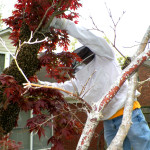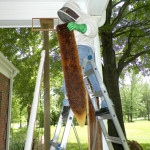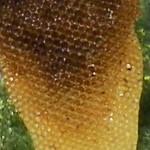“Swarming is the natural reproduction of a colony,” said David Glover, owner of The Bartlett Bee Whisperer business.
The swarm takes the queen with her when it departs.
“The swarm moves to the speed of the queen and appears like a bee tornado, with the workers spinning around their slower-flying mother,” he said. “She hasn’t flown since her mating flight, so she’s a little slow; plus, she has a bulkier body.”
The first order of business for the swarm, which is 15,000 to 30,000 bees, is to find a new home.
They are looking for real estate that is protected, like a hollow tree. In it, they build comb for incubating eggs and depositing pollen, used for producing and storing honey. They need at least 2 cubic feet of space, ideally with an entrance between 5/16 of an inch to 2 inches.
“When and where the queen stops, the whole colony stops and clusters,” Glover said. “A swarm cluster will remain together until they find a new home. The cluster can remain in one location from minutes to several days.”
While it might be alarming to see a massive cluster of bees hanging from a tree limb as they scope out new digs, it usually doesn’t pose a threat to humans, because a bee uses its stinger as a defense mechanism.
“In swarm mode, there’s no honey, no comb, no eggs, so they have nothing to defend,” Glover said.
If no trees are available, the bees will compromise and settle for alternative housing, like an attic, eave, or a garage.
“If they can’t find a tree, our houses and attics are giant trees to them,” he said.
When homeowners discover a hive or suspect they have bees, it often prompts a call to Glover, who specializes in removing and relocating bee colonies.
“Most people are afraid of bees,” Glover said.
Raised on a farm in McNairy County, he doesn’t fall into that category.
He said he’s always been fascinated by bees, and although he worked in operations management during his first career, since 2010 he’s been a beekeeper.
A member of the Memphis Area Beekeepers Association, Glover has removed hives from many homes and also has relocated them from the wild.
A sign that a swarm is setting up house in or around a home is that there is usually a small group of bees, maybe five or six, buzzing about a certain area where there is a hole large enough to allow the bees to come and go.
It doesn’t take them long to set up house.
“Immediately after finding a new home they start building comb,” Glover said. “Most people don’t see the hive move in.”
That’s because bees leave the hive early in the morning in search of pollen, and don’t return until the evening, when they deposit collected pollen in the honeycomb.
When Glover is called to a home, he assesses what needs to be done and explains the process to the home or property owner.
He brings with him a thermal camera that helps him find the exact location of the hive. Finding right where to cut into a structure minimizes damage.
He doesn’t kill the bee colony, but instead transports the comb to a frame that will fit inside a hive box. Once the queen is inside, all the other bees will follow her. Then it’s just a matter of scooping up stragglers and removing the comb and honey.
Removing all the comb and the honey it contains is critical, because nature has a way of cleaning up after itself when bees move away from home.
If comb and honey are left behind, it draws other pests, like wax moths, ants, roaches and rats.
“It’s a progression of pests,” Glover said.
Comb and honey removal are usually not part of an exterminator’s service.
Glover’s fees depend on the area a hive occupies. Rates start at a $300 minimum (the average for most removals), which covers up to 4 cubic feet.
The largest hive Glover has removed covered 22 feet and contained 25 gallons (220 pounds) of honey.
Glover also relocates hives from trees, but that process can take up to nine weeks, whereas removal from a home generally takes five to six hours.
To contact Glover, go to thebartlettbeewhisperer.com or visit his Facebook Page, The Bartlett Bee Whisperer.
Written by Suzanne Thompson, special to the Express. Contact her at writer4561@yahoo.com.





A very interesting article.
I really admire this man and his services.
Jim Hartsfield/Bartlett, TN.